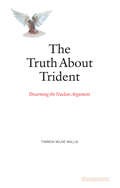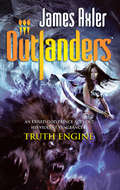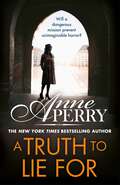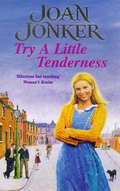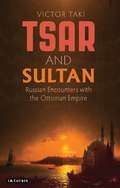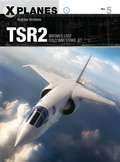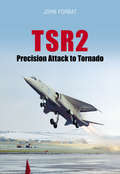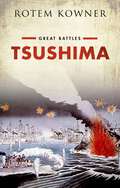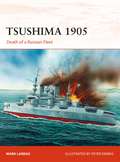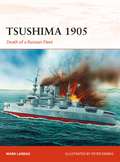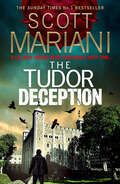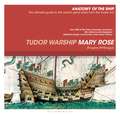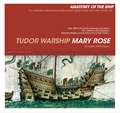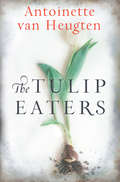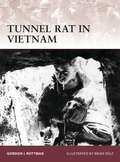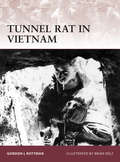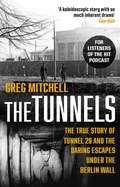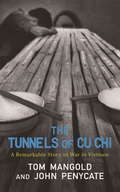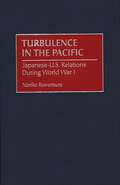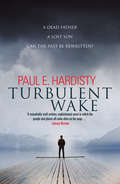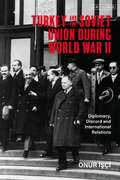- Table View
- List View
The Truth About Trident: Disarming the Nuclear Argument
by Timmon Milne WallisThe UK is one of nine states possessing nuclear weapons. Renewal of the Trident programme would extend Britain’s commitment to so-called nuclear ‘deterrence’ well into the second half of this century, despite treaty obligations and an ‘unequivocal undertaking’ to disarm. With more than 16,000 nuclear weapons stockpiled worldwide, the risk of one going off by accident or design is increasing every day.Wallis in The Truth about Trident explores the issues Trident presents and raises questions like: what would be the impact of their use? How safe are they in the meantime? Are they really necessary? Can we afford them? Are there better alternatives? This book aims to peel back layers of confusion and deceit to reach the truth about Trident.
Truth Engine
by James AxlerEarth's darkest days have given way to a new age of war. Launched by an ancient and powerful alien race, the battle has morphed through an aeons-old blueprint for domination.
A Truth To Lie For (Elena Standish Book 4)
by Anne PerryThe fourth novel in Anne Perry's breathtakingly tense and exciting spy thriller series, featuring young British photographer and secret agent Elena Standish, who will need every ounce of her strength and ingenuity to survive what lies ahead...It is the summer of 1934 when MI6 receives intelligence that two German scientists have made a breakthrough in germ warfare. British agent Elena Standish must return to Berlin to prevent unimaginable horror and, with the help of her trusted friend, Jacob Ritter, embark upon a mission fraught with fear and uncertainty. Meanwhile, her grandfather's old adversary Johann Paulus has risen to power as an adviser to Hitler. By his side is his loyal supporter Hans Beckendorff, who is married to Elena's childhood friend. But when Hans witnesses the bloodshed and atrocities of the Night of the Long Knives, he is torn between ambition and the realisation that he must protect his family from harm.
Try a Little Tenderness: A heart-warming wartime saga of a troubled Liverpool family
by Joan JonkerWith the country on the brink of war, a family also faces struggles closer to home. Try a Little Tenderness is a moving wartime saga, which sees Joan Jonker weave her magic once again in an unforgettable tale that is sure to stay with you long after you have finished the last page. Perfect for fans of Lindsey Hutchinson and Dilly Court. Jenny and Laura Nightingale are as different as chalk and cheese. Jenny's pretty face and lively sense of humour make her everyone's favourite girl, whereas Laura is mean and moody and she's never out of trouble. Their mother, Mary, loves them both and frets about Laura's behaviour, but soon that's the least of her worries... Her father's new young wife, Celia, is about to bring shame on the family by leading Laura astray. Jenny attracts the attention of two young lads in her street who both want to court her. Mick and John have been mates since they were kids but now war is declared, and it's every man for himself! Meanwhile Laura's resentment begins to build and it's only a matter of time before things come to a head. Who will learn that a little tenderness goes a long way? What Amazon readers are saying about Try a Little Tenderness: 'Yet another hilarious and life like read. Growing up is not easy for anyone but this book shows that there is light at the end of the teenage years. The characters are so witty you can't help but wish you were their friend too! It shows that life is never easy, but there is always somebody there to lend moral support, a joke or a cup of sugar! Highly recommended''AMAZING. Always a pleasure to read. I always enjoy these books, you lose yourself in them every time you pick them up'
Tsar and Sultan: Russian Encounters with the Ottoman Empire (Library of Ottoman Studies)
by Victor TakiFrom the 1700s, the declining Ottoman Empire served as a source of inspiration for the westernisation of Russia. Comparisons between European and Ottoman diplomacy, warfare and political organizations shaped Russian identity and provided the nation with a sense of superiority over its adversary. Tsar and Sultan offers a unique insight into Russian Orientalism as the intellectual force behind Russian-Ottoman encounters. Through war diaries and memoirs, accounts of captivity and diplomatic correspondences, Victor Taki's analysis of military documents demonstrates a crucial aspect of Russia's discovery of the Orient based on its rivalry with the Ottoman Empire. Narratives depicting the brutal realities of Russian-Turkish military conflicts influenced the Orientalisation of the Ottoman Empire. In turn, Russian identity was built as the counter-image to the demonised Turk. This book explains the significance of Russian Orientalism on Russian identity and national policies of westernisation. Students of European History and Middle East studies will appreciate Taki's analysis of Russian-Turkish relations and their influence on Eurasian history.
TSR2: Britain's lost Cold War strike jet (X-Planes)
by Andrew Brookes Adam ToobyThe TSR2 is one of the greatest 'what-if' aircraft of the Cold War, whose cancellation still generates anger and controversy among aviation fans. It was a magnificent, cutting-edge aircraft, one of the most striking of the Cold War, but fell victim to cost overruns, overambitious requirements, and politics. Its scrapping marked the point when Britain's aerospace industry could no longer build world-class aircraft independently. After the demise of TSR2 the RAF's future jets would be modified US aircraft like the Phantom and pan-European collaborations like Tornado and Typhoon.In this book the eminent air power analyst and ex-Vulcan bomber pilot Andrew Brookes takes a fresh, hard-headed look at the TSR2 project, telling the story of its development, short career and cancellation, and evaluating how it would have performed in Cold War strike roles as well as in the recent wars in the Middle East.
TSR2: Navigation and Weapon Delivery
by John ForbatIncluded are details on the ground-breaking navigation and attack system, its Cold War context, its requirements and the development of ATF (advanced terrain following), and in-depth analysis of automatic flight control systems, analogue and digital simulations at Weybridge and the reconnaissance pack for mapping enemy territory. It finishes with a look at the final throes of TSR2's cancellation by the Labour government in 1965.
Tsushima: Great Battles Series (Great Battles)
by Rotem KownerThe Battle of Tsushima was the most decisive naval engagement in the century that elapsed since the Battle of Trafalgar in 1805. Although these two battles are often compared, the Battle of Tsushima, in which the Japanese Imperial Navy defeated the Russian Imperial Navy, was also unprecedented in many ways. It marks the first naval victory of an Asian power over a major European power; the most devastating defeat suffered by the Imperial Russian Navy in its entire history; and the only truly decisive engagement between two battleship fleets in modern times. In addition, the Battle of Tsushima was also the most decisive naval engagement of the Russo-Japanese War and one that exerted a major impact on the course of that war. Its impact was so dramatic, in fact, that the two belligerents concluded a peace agreement within three months of the battle's conclusion. At the same time, and because it involved two of the world's largest fleets, the influence this battle exerted was both far reaching and long standing. In subsequent years, the symbolic victory of an "Eastern" power over Tsarist Russia using modern technology was feared and celebrated in both the Western and the Colonial worlds. Similarly, and in both Japan and Russia, the Battle of Tsushima had a prolonged impact on their respective navies as well as on their geopolitical ambitions in Asia and beyond. By relying on a diverse array of primary sources, this book examines the battle in depth and is the first to offer a penetrating analysis of its global impact as well as the way its memory has evolved in both Japan and Russia.
Tsushima: Great Battles Series (Great Battles)
by Rotem KownerThe Battle of Tsushima was the most decisive naval engagement in the century that elapsed since the Battle of Trafalgar in 1805. Although these two battles are often compared, the Battle of Tsushima, in which the Japanese Imperial Navy defeated the Russian Imperial Navy, was also unprecedented in many ways. It marks the first naval victory of an Asian power over a major European power; the most devastating defeat suffered by the Imperial Russian Navy in its entire history; and the only truly decisive engagement between two battleship fleets in modern times. In addition, the Battle of Tsushima was also the most decisive naval engagement of the Russo-Japanese War and one that exerted a major impact on the course of that war. Its impact was so dramatic, in fact, that the two belligerents concluded a peace agreement within three months of the battle's conclusion. At the same time, and because it involved two of the world's largest fleets, the influence this battle exerted was both far reaching and long standing. In subsequent years, the symbolic victory of an "Eastern" power over Tsarist Russia using modern technology was feared and celebrated in both the Western and the Colonial worlds. Similarly, and in both Japan and Russia, the Battle of Tsushima had a prolonged impact on their respective navies as well as on their geopolitical ambitions in Asia and beyond. By relying on a diverse array of primary sources, this book examines the battle in depth and is the first to offer a penetrating analysis of its global impact as well as the way its memory has evolved in both Japan and Russia.
Tsushima 1905: Death of a Russian Fleet (Campaign)
by Peter Dennis Mark Lardas Nikolai Bogdanovic Bounford.com Bounford.com Paul KimeJapan was closed to the world until 1854 and its technology then was literally medieval. Great Britain, France and Russia divided the globe in the nineteenth century, but Japan was catching up. Its army and navy were retrained by Western powers and equipped with the latest weapons and ships. Japan wanted to further emulate its European mentors and establish a protectorate over Korea, yet Japanese efforts were blocked by Imperial Russia who had their own designs on the peninsula.The Russo-Japanese War started with a surprise Japanese naval attack against an anchored enemy fleet still believing itself at peace. It ended with the Battle of Tsushima, the most decisive surface naval battle of the 20th century. This gripping study describes this pivotal battle, and shows how the Japanese victory over Russia led to the development of the dreadnought battleship, and gave rise to an almost mythical belief in Japanese naval invincibility.
Tsushima 1905: Death of a Russian Fleet (Campaign #330)
by Mark LardasJapan was closed to the world until 1854 and its technology then was literally medieval. Great Britain, France and Russia divided the globe in the nineteenth century, but Japan was catching up. Its army and navy were retrained by Western powers and equipped with the latest weapons and ships. Japan wanted to further emulate its European mentors and establish a protectorate over Korea, yet Japanese efforts were blocked by Imperial Russia who had their own designs on the peninsula.The Russo-Japanese War started with a surprise Japanese naval attack against an anchored enemy fleet still believing itself at peace. It ended with the Battle of Tsushima, the most decisive surface naval battle of the 20th century. This gripping study describes this pivotal battle, and shows how the Japanese victory over Russia led to the development of the dreadnought battleship, and gave rise to an almost mythical belief in Japanese naval invincibility.
The Tudor Deception (Ben Hope #28)
by null Scott MarianiAn unmissable new thriller from the master of the genre An unsolved historical mystery. A brutal bomb attack. Only one man can track down the killers that link them both. It’s 2005: Ben Hope, recently retired from the military, is living in Ireland and using his SAS skills to find and rescue missing children. But when asked to take on the case of two boys who disappeared centuries ago, he walks away, little realising he’s lit a fuse that will not only destroy the life of someone he cares about, but also lead him on a journey that proves old secrets come with a very modern price. Ben must follow the trail across Europe, unravelling the mystery and dodging bullets as only he can. As the death toll ramps up, what is the connection between a murdered history professor, an English lord and a pretender to the Tudor throne – and can Ben find out the truth before the killers make him their next victim?
Tudor Warship Mary Rose (Anatomy of The Ship)
by Douglas McElvogueThe great warship the Mary Rose was built between 1509 and 1511 and served 34 years in Henry VIII's navy before catastrophically sinking in the Battle of the Solent on 19 July 1545. A fighting platform and sailing ship, she was the pride of the Tudor fleet. Yet her memory passed into undeserved oblivion – until the remains of this magnificent flagship were dramatically raised to the surface in 1982 after 437 years at the bottom of the Solent. Part of the bestselling Conway Anatomy of The Ship series, Tudor Warship Mary Rose provides the finest possible graphical representation of the Mary Rose. Illustrated with a complete set of scale drawings, this book contains technical plans as well as explanatory views, all with fully descriptive keys. Douglas McElvogue uses archaeological techniques to trace the development and eventful career of Henry VIII's gunship, while placing it in the context of longer-term advances in ship construction. This volume features:-The first full archaeological reconstruction of the Mary Rose, as she would have appeared when built and when she sank.-The concepts behind the building of the ship, along with consideration of the materials used and her fitting-out and manning.-The ship's ordnance, including muzzle loaders, breech loaders, firearms, bows,staff weapons, bladed weapons and fire pots.-Analysis of the contemporary descriptions of the Mary Rose's sailing characteristics and ship handling, whether general sailing, heavy weather sailing, anchoring, mooring, stemming the tide or riding out storms.-A service history of the Mary Rose examining the campaigns of the vessel: the battles she was involved in, when she held station in the Channel and the periods in which she was laid up.
Tudor Warship Mary Rose (Anatomy of The Ship)
by Douglas McElvogueThe great warship the Mary Rose was built between 1509 and 1511 and served 34 years in Henry VIII's navy before catastrophically sinking in the Battle of the Solent on 19 July 1545. A fighting platform and sailing ship, she was the pride of the Tudor fleet. Yet her memory passed into undeserved oblivion – until the remains of this magnificent flagship were dramatically raised to the surface in 1982 after 437 years at the bottom of the Solent. Part of the bestselling Conway Anatomy of The Ship series, Tudor Warship Mary Rose provides the finest possible graphical representation of the Mary Rose. Illustrated with a complete set of scale drawings, this book contains technical plans as well as explanatory views, all with fully descriptive keys. Douglas McElvogue uses archaeological techniques to trace the development and eventful career of Henry VIII's gunship, while placing it in the context of longer-term advances in ship construction. This volume features:-The first full archaeological reconstruction of the Mary Rose, as she would have appeared when built and when she sank.-The concepts behind the building of the ship, along with consideration of the materials used and her fitting-out and manning.-The ship's ordnance, including muzzle loaders, breech loaders, firearms, bows,staff weapons, bladed weapons and fire pots.-Analysis of the contemporary descriptions of the Mary Rose's sailing characteristics and ship handling, whether general sailing, heavy weather sailing, anchoring, mooring, stemming the tide or riding out storms.-A service history of the Mary Rose examining the campaigns of the vessel: the battles she was involved in, when she held station in the Channel and the periods in which she was laid up.
The Tulip Eaters (Mira Ser.)
by Antoinette van HeugtenIn a riveting exploration of the power the past wields over the present, critically acclaimed author Antoinette van Heugten writes the story of a woman whose child’s life hangs in the balance, forcing her to confront the roots of her family’s troubled history in the dark days of World War II…
The Tulip Tearooms: A compelling saga of heartache and happiness in post-war London
by Pamela EvansTHE TULIP TEAROOMS is a heartwarming and poignant saga from Pam Evans, set in London just after the Second World War. Perfect for readers of Kitty Neale, Katie Flynn and Dilly Court.The Second World War is finally over when Lola Brown meets Harry Riggs at a dance. It is love at first sight but when Harry tells Lola that he is a policeman, her heart sinks. Lola's father is a petty criminal, and if Harry ever finds out and turns him in, it will destroy her family...Harry reluctantly accepts that Lola doesn't want to see him again, and eventually starts to find happiness without her. In the meantime, Lola encounters the eccentric Pickford sisters and sets about transforming their run-down tearooms in London's West End, only to find her own life transformed as well. Despite everything, Harry and Lola continue to feel drawn to each other, but the truth about Lola's family can't stay hidden for ever...
Tumult in the Clouds: Original Edition (Penguin World War II Collection)
by James GoodsonAnglo-American James Goodson's war began on Sept 3rd 1939, when the SS Athenia was torpedoed and sank off the Hebrides. Surviving the sinking and distinguishing himself rescuing survivors, Goodson immediately signed on with the RAF. He was an American, but he wanted to fight.Goodson flew Spitfires for the RAF before later joining his countrymen with the Fourth Fighter Group to get behind the controls of Thunderbolts and Mustangs where he became known as 'King of the Strafers'.Chock full of breathtaking descriptions of aerial dogfights as well as the stories of others of the heroic 'few', Tumult in the Clouds is the ultimate story of War in the air, told by the one of the Second World War's outstanding fighter pilots.
Tunnel Rat in Vietnam (Warrior)
by Gordon L. Rottman Brian DelfIn 1965, soon after the first US combat troops had arrived in Vietnam, it was realized that in some areas the Viet Cong had developed vast tunnel complexes in which to hide from the enemy. It was long known that such complexes existed, but it was not realized just how extensive they were in some areas, how important they were to the Viet Cong, and how difficult it was to detect and neutralize them. At first infantrymen volunteered to enter the tunnels armed with only pistols and flashlights – the 'tunnel runners' were born, known to the Australians as 'tunnel ferrets'. Starting as an ad hoc force of infantrymen, combat engineers and chemical troops, it was not long before units were 'formalized' as 'tunnel exploration personnel' and 4–6-man 'tunnel exploitation and denial teams' were created. They came to be known simply as 'tunnel rats' with the unofficial motto Non Gratum Anus Rodentum – 'Not Worth a Rat's Ass'. This title will be based on the personal accounts of those who served in this unique role and will describe the specialist training and equipment, not to mention the tactics and combat experiences, of those who fought an underground war against the Viet Cong in Vietnam.
Tunnel Rat in Vietnam (Warrior #161)
by Gordon L. Rottman Brian DelfIn 1965, soon after the first US combat troops had arrived in Vietnam, it was realized that in some areas the Viet Cong had developed vast tunnel complexes in which to hide from the enemy. It was long known that such complexes existed, but it was not realized just how extensive they were in some areas, how important they were to the Viet Cong, and how difficult it was to detect and neutralize them. At first infantrymen volunteered to enter the tunnels armed with only pistols and flashlights – the 'tunnel runners' were born, known to the Australians as 'tunnel ferrets'. Starting as an ad hoc force of infantrymen, combat engineers and chemical troops, it was not long before units were 'formalized' as 'tunnel exploration personnel' and 4–6-man 'tunnel exploitation and denial teams' were created. They came to be known simply as 'tunnel rats' with the unofficial motto Non Gratum Anus Rodentum – 'Not Worth a Rat's Ass'. This title will be based on the personal accounts of those who served in this unique role and will describe the specialist training and equipment, not to mention the tactics and combat experiences, of those who fought an underground war against the Viet Cong in Vietnam.
The Tunnels: The Untold Story of the Escapes Under the Berlin Wall
by Greg Mitchell'A story with so much inherent drama... a kaleidoscopic cold war story.' The GuardianIn the summer of 1962, one year after the rise of the Berlin Wall, a group of daring young West Germans risked prison, Stasi torture and even death to liberate friends, lovers, and strangers in East Berlin by digging tunnels under the Wall. Then, as the world’s press heard about the secret projects, two television networks raced to be the first to document them from the inside, funding two separate tunnels for exclusive rights to film the escapes. In response, President John F. Kennedy and his administration, wary of anything that might raise tensions and force a military confrontation with the Soviets, maneuvered to quash both documentaries. As Greg Mitchell's riveting narrative unfolds, we meet extraordinary characters: the legendary cyclist who became East Berlin’s most wanted man; the tunneller who had already served four years in the East German gulag; the Stasi informer who betrays the ‘CBS tunnel’; the young East Berliner who escapes with her baby, then marries one of the tunnellers; and an engineer who would later help build the tunnel under the English Channel.Capturing the hopes and fears of everyday Berliners, the chilling reach of the Stasi secret police, and the political tensions of the Cold War, The Tunnels is breaking history, a propulsive read whose themes still reverberate today.
The Tunnels of Cu Chi: A Remarkable Story of War
by Tom Mangold John PenycateThe story of an extraordinary campaign in the Vietnam War - fought in a 200-mile labyrinth of underground tunnels and chambers.The campaign in the tunnels of Cu Chi was fought with cunning and savagery between Viet Cong guerrillas and special teams of US infantrymen called 'Tunnel Rats'. The location: the 200-mile labyrinth of underground tunnels and secret chambers that the Viet Cong had dug around Saigon.The Tunnel Rats were GIs of legendary skill and courage. Armed only with knives and pistols, they fought hand-to-hand against a cruel and ingenious enemy inside the booby-trapped blackness of the tunnels. For the Viet Cong the tunnel network became their battlefield, their barracks, their arms factories and their hospitals, as the ground above was pounded to dust by American shells and bombs.
Turbulence in the Pacific: Japanese-U.S. Relations During World War I (International History)
by Noriko KawamuraAlthough events in East Asia were a sideshow in the great drama of World War I, what happened there shattered the accord between Japan and the United States. This book pursues the two-fold question of how and why U.S.-Japanese tensions developed into antagonism during the war by inquiring into the historical sources of both sides. Kawamura explains this complex phenomenon by looking at various factors: conflicts of national interests—geopolitical and economic; perceptual problems such as miscommunication, miscalculation, and mistrust; and, most important of all, incompatible approaches to foreign policy. America's universalism and the unilateralism inherent in Wilsonian idealistic internationalism clashed with Japan's particularistic regionalism and the pluralism that derived from its strong sense of racial identity and anti-Western nationalistic sentiments.By looking at the motives and circumstances behind Japan's expansionist policy in East Asia, Kawamura suggests some of the centrifugal forces that divided the nations and challenged the premise of Wilsonian internationalism. At the same time, through critical examination of the Wilson administration's universalist and unilateral response to Japan's actions, she raises serious questions about the effectiveness of American foreign policy. At the close of the 20th century, after 50 years of Cold War, those in search of a new world order tend to resort to Wilsonian rhetoric. This book suggests that it can be unwise to apply a universalistic and idealistic approach to international conflicts that often result from extreme nationalism, regionalism, and racial rivalry.
Turbulent Wake
by Paul E. HardistyA stark, eye-opening and exquisitely poignant new novel spanning the globe and probing the issues that define our times. As a young man comes to terms with his father’s death, he is forced to face his own demons, and confront the possibility of change…‘This is a remarkably well-written, sophisticated novel in which the people and places all come alive on the page…’ Literary Review‘Searing … at times achieves the level of genuine poetry’ Publishers WeeklyEthan Scofield returns to the place of his birth to bury his father. Hidden in one of the upstairs rooms of the old man’s house he finds a strange manuscript, a collection of stories that seems to cover the whole of his father’s turbulent life.As his own life starts to unravel, Ethan works his way through the manuscript, trying to find answers to the mysteries that have plagued him since he was a child. What happened to his little brother? Why was his mother taken from him?And why, in the end, when there was no one else left, did his own father push him away?Swinging from the coral cays of the Caribbean to the dangerous deserts of Yemen and the wild rivers of Africa, Turbulent Wake is a bewitching, powerful and deeply moving story of love and loss … of the indelible damage we do to those closest to us and, ultimately, of the power of redemption in a time of change.‘The quality of Hardisty’s writing and the underlying truth of his plots sets this above many other thrillers’ West Australia‘Turbulent Wake is moving, it caused me to ache deep inside, oh, and it is also a rather beautiful read too’ LoveReading‘The writing is sublime! SO different from the Claymore Straker series but just as compelling - a round-the-world journey through a lifetime of regrets. Wow!’ Off-the-Shelf Books‘If you like literary fiction with heart then you MUST read the stunning Turbulent Wake – powerful, evocative, profound; I savoured every word’ Karen Cole‘Turbulent Wake is a truly beautiful story … what a special book this is’ Jen Meds Book Reviews‘Evocative, compelling, a pull-at-your-heartstrings page turning read! A book that you will absorb into your very soul! Go and get a copy today!’ Crime Book Junkie‘Turbulent Wake is a beautifully written and atmospheric read that will stay with me for a long time … The author’s vivid descriptions are wonderful and I felt like I had a fly on the wall view of everything that was happening’ Over the Rainbow Book Blog‘Powerful, evocative, profound; I savoured every word’ Hair Past a Freckle‘Compelling and inspiring, it is an adventure, a journey, a exploration of life, a fascinating novel’ Swirl & Thread‘Heartbreaking, honest, wonderful. This novel needs to be read by many, so they can see what damage they cause’ Steph’s Book Blog
Turkey and the Holocaust: Turkey’s Role in Rescuing Turkish and European Jewry from Nazi Persecution, 1933–1945
by Stanford J. ShawThe neutrality maintained by Turkey during most of the Second World War enabled it to rescue thousands of Jews from the Holocaust in the Nazi-occupied or collaborating countries of Europe. This book shows how in France, the Turkish consuls in Paris and Marseilles intervened to protect Turkish Jews from application of anti-Jewish laws introduced both by the German occupying authorities and the Vichy government and rescued them from concentration camps, getting them off trains destined for the extermination chambers in the East, and arranging train caravans and other special transportation to take them through Nazi-occupied territory to safety in Turkey. 'an important and unique addition to the vast scholarship available on that tragic era' Rabbi Abraham Cooper
Turkey and the Soviet Union During World War II: Diplomacy, Discord and International Relations (Library of World War II Studies)
by Onur IsciBased on newly accessible Turkish archival documents, Onur Isci's study details the deterioration of diplomatic relations between Turkey and the Soviet Union during World War II. Turkish-Russian relations have a long history of conflict. Under Ataturk relations improved – he was a master 'balancer' of the great powers. During the Second World War, however, relations between Turkey and the Soviet Union plunged to several degrees below zero, as Ottoman-era Russophobia began to take hold in Turkish elite circles. For the Russians, hostility was based on long-term apathy stemming from the enormous German investment in the Ottoman Empire; for the Turks, on the fear of Russian territorial ambitions. This book offers a new interpretation of how Russian foreign policy drove Turkey into a peculiar neutrality in the Second World War, and eventually into NATO. Onur Isci argues that this was a great reversal of Ataturk-era policies, and that it was the burden of history, not realpolitik, that caused the move to the west during the Second World War.
